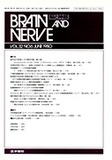Japanese
English
- 有料閲覧
- Abstract 文献概要
- 1ページ目 Look Inside
I.はじめに
悪性神経膠腫の頭蓋外転移は,1928年Davis8),の報告を嚆矢に,すでに著者らの調べ得た限りでは現在まで70例11,16,18〜23,25,29,32)の報告がみられるが,脳腫瘍の頭蓋外転移経路を追求し得た剖検例2,4,5,9,11,12,18,19,21,22,27,30,33)は意外に少なく,また原発脳腫瘍および頭蓋外転移部腫瘍の超微形態学的検索の報告25)はきわめて少ない。
悪性神経膠腫が,何故に頭蓋外組織に転移しにくいかということは,脳腫瘍の発生母地と転移部とが発生学的に全く相違している35)ことがまず第1にあげられるが,その他に神経管外では膠腫細胞に対する免疫反応が存在するためではないかなどの説37)があり),現在でも未解決の問題として残されている。
Extracranial metastasis of glioblastoma multi-forme which was confirmed by ultrastructual studies has been rarely reported. This is an autopsy report of a case of glioblastoma multiforme which revealed metastasizing to hilus pulmonary, parabronchus and right pulmonary lobe one month later after reoperation.
A 31-year-old male of right handed was admitted to department of neurosurgery in our hospital with chief complaints of headache in April, 1977. The physical examination and chest x-ray revealed no definite abnormality. Neurological examination also revealed no abnormal findings. However, mentally he was slightly dull and disorientated. Cerebral angiogram showed remarkable shifting of right anterior cerebral artery. The cerebral scinti-gram showed hot spot in the right fromtal area. CT scan also revealed enhanced high density areas in the same region (Fig.1). On May 11, 1977, the subtotal surgical removal of tumor was performed and at that time Ommaya's device was placed on the tumor bed with its reservoir which was fixed subcutaneous region on the skull. Microscopical diagnosis was glioblastoma multiforme. Adriamycin (total dose of 13 mg) was injected every other day by the percutaneous puncture into the Ommaya's reservoir. In addition, the patient was treated with Co60 irradiation (total dose of 6,000 rads). In November, 1977, the patient was discharged from our hospital with remarkable clinical im-provement. However, the evidences of the tumor recurrence was confirmed six month later, and partial surgical removal of tumor with decom-pression craniectomy procedure was performed in May, 1978. Selective arterial infusion of adriamycin (total dose of 115 mg) was followed after the re-operated procedure. The clinical course of patient in the hospital went rapidly downhill, and the patient expired by the complication of severe pneu-monia in June, 1978.
Autopsy finding (NMS-4654); Brain weight 1,500 gr. A postmorten examination revealed poorly defined and necrotic soft tumor mass, which was located at the corpus callosum, caudate nucleus, and deep white matter of frontal lobe on the right hemisphere (Fig. 2A). The tumor mass was obvi-ously invaded the dura mater along its rightfrontal convexity. The superior longitudinal sinus was occupied by extensively the tumor embolus (Fig. 2B). More importantly, the site of metastatic tumor observed hilus pulmonary, parabronchus and right pulmonary lobe (Fig. 3). There are no lymphadenopathy of cervical and other lymph nodi.
Histopathological investigation revealed pleo-morphic tumor which was composed mainly astro-cytic series and poorly spindle shaped cells, which tend to be arranged in the vascular channel with abundant giant cells (Figs. 4A, B). The tumor mass which was confirmed in the lung identically to the primary brain tumor except for the rather excessive present multinucleated bizarr cells. There were tumor embolus in a small vessels of the metastatic lung tumor (Fig. 5).
The ultrastructual investigation revealed the fine filamentous material measuring 80-90 angstroms in width, which was identified as the glial fibril was noted and junctional complex was distributed in intracellular spaces (Figs. 6A, 6B, 7, 8). Numerous junctional complex which showed close attachment cytoplasmic microfilament, which eventually merged with the cell membrane.
The glial nature of the metastasis was confirmed by electromicroscopic demonstration of glial fibrils occupying the cytoplasm of metastatic lung tumor. From these clinical course and histological features, it could be justified that glioblastoma multiforme metastasized to the lung by the route of hemato-genous metastasis. It is concluded that the ultra-structual studies were necessary for definiting the nature of tumor and histological diagnosis, because of brain and metastatic tumors were difficult in diagnosis for the changes of their nature by amount dose of administrated irradiation and chemo-therapeutic agents.

Copyright © 1980, Igaku-Shoin Ltd. All rights reserved.


